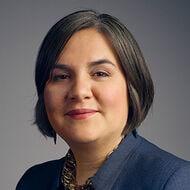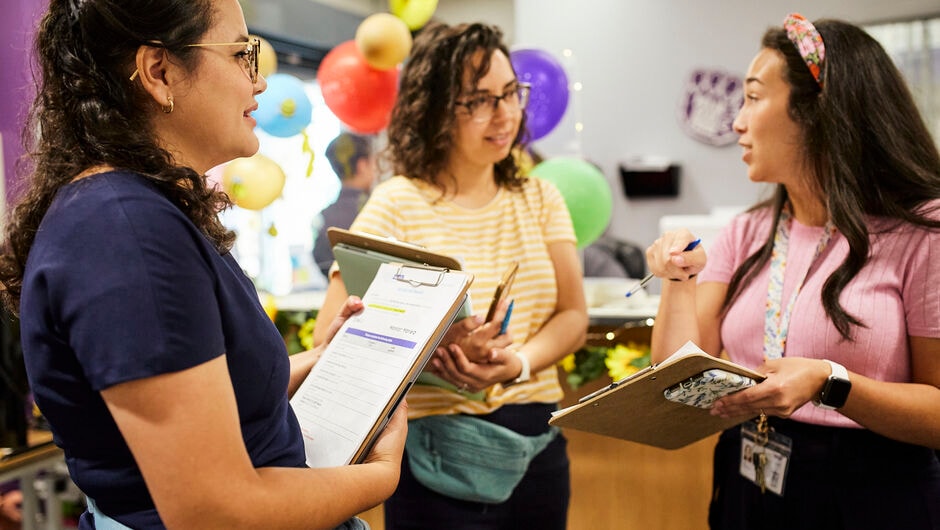
Culturally Responsive Support Is Key When College and COVID-19 Collide
Hispanic-serving institutions can help Latinx students attain a higher education despite the pandemic.
In elementary school, Rocio Monsiváis dreamed of becoming a lawyer. Academic success followed her, and she graduated high school as the salutatorian of her class. From there, she enrolled at the University of Texas at Austin, and after graduating she found herself, at 25, enrolled as a first-year student at St. Mary’s University School of Law.
On paper, her journey appears seamless. But as a first generation college student, she was beset by financial worries. For many years, Monsiváis lived apart from her mother, who was in Mexico, while she resided in Eagle Pass, a Texas border city. She had questions about the college application process that she figured out on her own. She credits her mother—and her own resilience—for her success. “Now that I can look back, I can see the path God was taking me on,” she said. “I am a lot more confident in what I’m doing.”
Monsiváis’ path was also made possible by decades of work by activists, parents, and civil rights groups to open doors and improve access to K-12 and higher education for a generation of Latinx students. The seeds of this generation’s success were planted by public schools, advocacy groups, parents, and others who filed and won lawsuits against states over inequitable school funding systems. The results: improved curriculum in poorer schools, like the high school Monsiváis attended in Eagle Pass, and better-trained instructors who teach Advanced Placement courses in science, math, literature, and history.
The coronavirus pandemic is threatening that progress. Targeted support, though, could help prevent significant setbacks in post-secondary enrollment and high school graduation rates for Latinx students after years of gains.
“No one in my family had ever done it (attended college). It was not easy.”
‘An Inflection Point’ to Post-Secondary Gains for Latinx Students
High school graduation rates for Hispanic students climbed to 82% in 2019, the most recent year available, from 73% in 2010, the first year the U.S. Department of Education collected that data. Previously, the Education Department only collected high school dropout rates; those, too, show significant improvement, dropping to about 8% in 2019 from about 17% in 2010.
The higher graduation rates, in turn, have fed surging college enrollments, from community colleges to public flagships to private elites. The biggest beneficiaries are Hispanic-serving institutions, or HSIs, a 1992 federal designation approved by Congress that sends more money to colleges and universities whose undergraduate enrollments reach at least 25% Hispanic students. In return, HSIs use the money to upgrade academics, enhance faculty development, and provide expanded services for Latinx students—a majority of whom are first generation—that range from academic counseling to tutoring. HSIs enrolled about 1.8 million Hispanic students in 2018, according to the Education Department.
“We are at an inflection point in Latinos’ higher education success,” said Antonio Flores, president of the Hispanic Association of Colleges and Universities, a consortium of 569 colleges and universities in the U.S., Puerto Rico, Latin America, and Spain. The association was founded and is based in San Antonio, the nation’s seventh largest city and the epicenter of the decades-long movement to expand Latinx educational opportunities. In each of the last several years, the association has added an average of 29 institutions to its roster of member colleges and universities, the growth reflecting the nation’s rising Latino population.
HSIs, Flores said, are key in aiding the ascendance of Latinx students because their expanded student services are complemented by their location. HSIs tend to be situated in urban areas, where Latinx and Black populations are significant, and the institutions are the most affordable among colleges and universities, enabling students to live at home while working and attending classes, Flores said. The result is a robust pipeline for students from high schools to two- and four-year institutions that are better prepared through expanded student services—like affinity groups and added attention to diversity hiring in key areas of staff and faculty—to support Latinx students.
But old hurdles remain, and new ones have emerged. COVID-19 and the lack of technology for distance learning struck especially hard at communities and schools serving significant numbers of Latinx students and other students of color. Last year, nine parents filed a lawsuit against the Los Angeles Unified School District, the nation’s second largest school system after New York City, over lack of technical access and support in schools serving Latinx and Black students.
Another challenge: Significantly fewer college students who were first-time freshmen in 2019 returned for classes at any institution of higher education the following year, according to the National Student Clearinghouse Research Center. Latinx students saw the steepest decline, falling 3.2 percentage points to 69%, according to that data.
Flores anticipates a continued decline in college enrollment—how much is still uncertain—in the years ahead as a result of COVID-19’s impact, and some colleges and universities identified as HSIs have shuttered satellite campuses because of the financial impact of the pandemic. “Those losses will be accounted for in due time,” he said.
Just as worrisome, Flores said, are attitudes of some white Americans toward immigrants, people with immigrant roots, and people of color. And even now, a cultural emphasis on family first keeps students at home and close to families for personal and financial reasons when they have the academic preparation to attend competitive colleges away from home. But the removal of institutional and cultural hurdles—a continuing process—has produced clearer paths for students like Monsiváis, the law student who plans to practice criminal law.
Seek Help to Clear Obstacles To Higher Education
Monsiváis’ journey, like those of other first generation college students, was not easy. She was born in Minnesota when her mother, also named Rocio, visited relatives there, but her mother is a Mexican citizen. For 10 years of her public school education, Monsiváis lived with friends or relatives in Eagle Pass, a Texas border town of 29,000, while her mother resided in Piedras Negras, a city of 245,000 across the border. The two talked by telephone during the week and would meet at the international bridge connecting the sister cities, where Rocio Monsiváis (the mother) would give her daughter food and encouragement for another week. In 2010, Monsiváis’ mother received her green card, and the two were reunited when Monsiváis began attending Eagle Pass High School.
Growing up without the daily presence of her parents—her father had disappeared years earlier and hadn’t been in touch with the family—gave Monsiváis a drive and confidence that she credits with carrying her through a world for which she had no familiarity, beginning with college applications. “No one in my family had ever done it,” she said of attending college. “It was not easy.”
While she was accepted at the University of Chicago, she declined admission; it was too far away—in another state—and Monsiváis said she felt a need to be closer to home to support her mother, who earned $20,000 a year working at a restaurant and later as a health care worker. Graduating from UT-Austin with two majors in economics and government, or political science, she also earned two minors in French and Spanish, and she completed the units for a third minor in calculus but it wasn’t counted because she hadn’t declared a third major.
If her life was hectic at college, it would become busier in the years that followed. After graduation, she worked as a paralegal at a civil law firm, then a criminal law firm, both in Austin. To earn money to support herself and her mother, Monsiváis also took jobs at a Walmart and at a farmer’s market. Those years matured her. “I needed to grow up,” she said.
Now in her mid-20s, Monsiváis decided to apply to law school, but the cost at St. Mary’s, the only law school to which she applied, unsettled her. Again, her mother offered encouragement. “Money had always been an obstacle,” Monsiváis said. But her mother told her, “You go, and you study. Those debts can be paid off.”
After taking out student loans, Monsiváis moved to San Antonio—and closer to Eagle Pass—in August to begin the next leg of her journey. Her experience taught her valuable lessons. Among them: “You have value, you are worth it,” she said. “Reach out to teachers, professors, mentors. Sometimes I think we’re afraid to ask questions because we feel like we should already know.”
Experience Shows There Is No One Way to College Success
Lizette Chavez, a first generation student in Bakersfield, California, would agree. As the daughter of working-class parents, she faced many of the same challenges, and like Monsiváis, she also graduated in 2012 as the salutatorian of her high school graduating class after taking a full complement of college preparatory courses. Chavez’s success was rewarded with a full ride at the University of California, Merced, the newest of the state’s 10-campus system and located in the agriculturally rich Central Valley.
But after a year at UC Merced, Chavez missed home. She also determined early on she was at an institution where she didn’t feel supported. “If I came home, I would have my family.”
She transferred in fall 2013 to California State University Bakersfield, which was also less expensive. She remembers immediately feeling “at home” on the campus. Financial pressures, however, prompted her to transfer again, this time to Bakersfield College, a community college that is also an HSI and was even less expensive than California State. Still living at home, Chavez secured an office job and helped her mother clean houses to generate income for herself and her family and to save money for her return to CSU Bakersfield.
At Bakersfield College, Chavez says her instructors were different from others she encountered at UC Merced and California State. “They know people have lives, jobs. They were compassionate,” she said.
At Bakersfield College, more of her professors were also Latinx, compared with California State and UC Merced, where she remembers most of her instructors were white.
Chavez’s educational journey, not uncommon for first generation students, also reflects the work the Hispanic Association of Colleges and Universities and others have done to make college pathways as seamless as possible for transfer between campuses. And while most first generation Latino students typically begin at community college and then move to a UC or Cal State campus, Chavez admits “I did it backwards.” Backward or not, finding her right fit was facilitated by the growing use of so-called higher education articulation agreements—institutions honoring the transfer of college credits from another institution—allowing students to continue their studies without facing the added cost of retaking classes they already completed at a different campus.
Now 27, a journalism major, and the former editor of the campus newspaper, Chavez left Bakersfield College to pursue full-time employment at The Bakersfield Californian newspaper, where she is an editor and designs pages for the daily’s magazine. She plans to finish her undergraduate degree soon, now with experience in navigating a college campus. Among the lessons she learned: “It’s okay to ask for help. It’s okay to be older in college.”
“Our parents don’t have these experiences,” Chavez said. “I didn’t know how to apply for scholarships. I had to figure it out on my own.”
Her younger brother benefited from her experience. “When it was my brother’s turn, he didn’t have the same obstacles because I helped him,” she said. Her brother is enrolled at Bakersfield College.
And her parents’ role? Chavez credits them with providing critical support and inspiration.
“My parents were always big on education,” she said. Her father, Marco Chavez, earned a GED. He runs his own Bakersfield auto repair shop. Her mother, Elizabeth, earned an accounting degree in Mexico. And to punctuate the importance of education, Marco Chavez occasionally told his daughter to look at his rough hands.
“Look at these hands,” he would say. “I want you to have soft hands.”
We want to hear your opinions! To submit an idea for an Opinion piece or offer feedback on this story, visit our Suggestion Box.
Sign up to receive articles like this in your inbox!
Thanks for signing up!
Content is loading...







